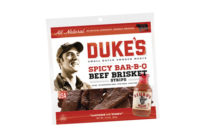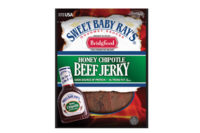A longtime snack favorite, pork rinds are garnering new fans, thanks to their better-for-you ingredients and innovative flavors.
They’re low in carbohydrates, high in protein, crunchy and flavorful, yet many consumers are still unfamiliar with one of the healthier snacks on the market—pork rinds. “We have less than 20% [household penetration],” says Mark Singleton, vice president of sales and marketing, Rudolph Foods Co. Inc. “Millions of consumers are still unaware of pork rinds and the fact that they contain zero carbohydrates and [have] high-satiety attributes.”
Still, the Lima, OH-based company, which makes and sells pork rinds and cracklins under the Lee’s, Pepe’s, Rudolph’s and Southern Recipe brands, continues to see “good growth as a company and a category,” Singleton says. “Accordingly, grocery store sales are up 5.6% the last 12 weeks, while only being up a couple of percent for the last 52 weeks. [Convenience] store sales have been much stronger, with growth of 6.4% over the last 12 weeks and 5.3% the last 12 months. We believe continued growth in the economy as a whole bodes well for snacking and pork rinds.”
Growth in the construction field and other male-dominated industries means more on-the-go men are likely to stop at convenience stores before work or during lunch to buy something to eat. “They are usually looking for a snack that’s filling, but still affordable,” explains Singleton. “With higher protein than almonds, mixed nuts and a boiled egg, pork rinds fulfill that need.”
Luke Mapp, director of marketing, Mikesell’s Potato Chip Co., Dayton, OH, also says that his company’s pork rinds and cracklins’ are purchased mostly by blue-collar and Hispanic males and at convenience (C-stores). However, the “continued recognition and education of the health benefits of pork rinds as a whole, including protein-based diets such as the Paleo diet and the Caveman diet, continue to drive [pork rind] sales,” he adds. “So far this year, the pork rind category is up 6.4% in C-stores and up 1.8% in grocery stores.”
Like Mapp, Laddie Fulcher, chief financial officer, Turkey Creek Snacks, Thomaston, GA, finds that consumers seeking healthier snack options are giving pork rinds a try. “A majority of consumers are extending their definition of ‘snacks’ to include more good-for-you snacks, and demand for healthy snacks is growing,” he says. “This trend has added more recognition to pork rinds as a healthy snack food, with no carbs, zero grams of trans-fat and high amounts of protein.”
Turkey Creek Snacks sells its pork rinds and cracklins in a variety of flavors, including Chili-Limon, Salt & Vinegar and Barbecue, at convenience and grocery stores.
From flavorings to packaging
Unlike chips, crackers and other snacks that are being offered in new textures, shapes and ingredients (sweet potato and parsnips, for instance) to attract new consumers, pork rinds are still made primarily from pork skin that’s fried into bite-size nuggets. As a result, pork-rind manufacturers look to interesting, new flavors to spice up their product lines.
“Hot flavors are still king,” Singleton says. “However, we are seeing more demand for more complex, hot flavors. Unique flavor combinations have included spicy vinegar flavors or combinations of sweet and heat.”
This summer, Rudolph Foods plans to release Tejalapeno, a special blend created with Tim Byres, co-owner and chef at Smoke in Dallas. “Tejalapeno is a unique blend of jalapeño and lime flavors with a Texas kick,” says Singleton. “This product is answering consumer demand for more complex and interesting flavors.”
Fulcher and Mapp both say their companies will be adding new flavors to their pork rinds lines soon as well.
In recent years, Turkey Creek Snacks also has added bag sizes to meet consumer demands, says Fulcher. “We have introduced more smaller serving sizes to give consumers choices to satisfy their preferences,” he explains.
Regarding required revisions to the Nutrition Facts Panel on packaging, Fulcher says the changes initially will be an added expense for suppliers. “However, with the growing demands of consumers seeking healthier snacks, it should reinforce more positive attention and confirm to consumers that pork rinds are a healthy snack food,” he adds.
Rudolph Foods thinks consumers want to see pork rinds’ packaging evolve, and is preparing to address this demand. “In the coming months, we are going to have new packaging graphics on the shelf we think will really catch the consumer’s eye,” Singleton says. “We think this new packaging with updated graphics will inspire some new folks to give our favorite snack a try. In addition, we have reduced our carbon footprint through a more efficient design. Our bag film is also made in a sustainable ‘green’ printing facility.”
Similar challenges, opportunities
Like other snack manufacturers, pork rind producers are facing both challenges and opportunities. Besides the challenge of overcoming consumers’ misperception of pork rinds, pork rind producers are, like their processors, seeing a tightening in ingredient supply and higher ingredient costs.
“One of the largest U.S. pork producers was purchased by a Chinese company,” Mapp explains. “As a result of this sale, a greater amount of pork is being exported to the China market. This is a challenge for production/capacity in the U.S. market to meet demand and, as such, is affecting prices in the U.S. There is, however, potential opportunity for increased sales in international markets, including South America and Europe.”
Turkey Creek Snacks’ Fulcher also says higher pork prices are one of the biggest challenges facing the category. But pork rind manufacturers also have ample opportunities to garner new customers, increase their sales and mitigate the impact of higher ingredient prices on their bottom line.
“Continued awareness and education of the great taste and high-protein benefits of pork rinds is the leading opportunity for growth in the pork-rind category,” says Mapp.
A lack of brand identity
Fulcher agrees. “We need to ensure that consumers are aware that pork rinds are a good-for-you snack,” he says, adding that pork rind manufacturers should also continue to develop flavors that meet the taste preference of existing and new consumers. “The outlook for pork rinds looks very promising, with the addition of variety and unique flavors, which provide consumers multiple choices to ensure that snacking doesn’t become boring.”
“We would like to see pork rinds begin to compete as a meat snack,” says Singleton. “Currently, pork rinds compete against potato chips, while our real equal is jerky.” The latter category has been steadily growing in popularity among health-conscious consumers, especially women and young adults.
Singleton also points out that the current lack of brand identity in the category offers manufacturers an opportunity. “Consumers know what flavor of pork rinds they like, but there’s a lack of brand loyalty,” he explains. “We think there is a lot of potential to build consumer loyalty through social media and brand development campaigns.”
Pork rind manufacturers have always known that their products are healthier than, and as tasty as, many other snacks on the market. Now, more consumers are discovering the attributes of these crunchy, protein-rich treats, too, and going hog wild over them.







